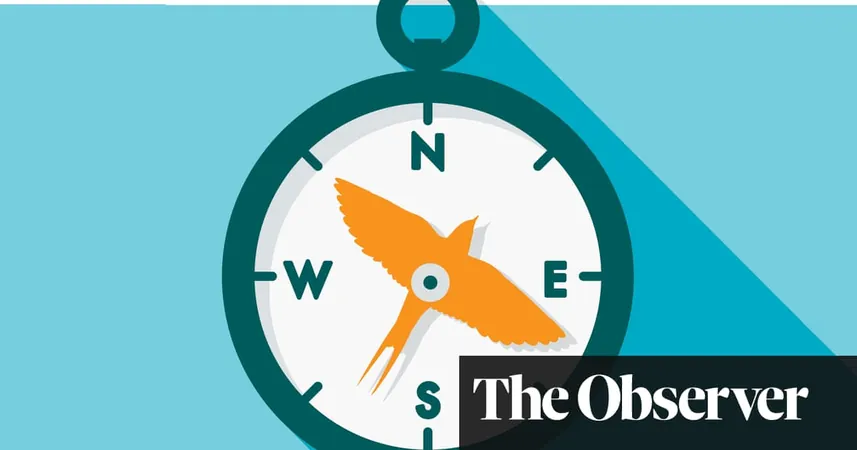
Unlocking the Mysteries of Migration: How Quantum Mechanics Guides Birds Home
2025-03-23
Author: Arjun
Introduction
When the cheerful melodies of chiffchaffs and wheatears fill the air, it’s a sure sign that spring has arrived. By March, these avian travelers embark on their remarkable journeys back to breeding grounds, traversing thousands of kilometers and often returning with astonishing precision. While many envision migration as large flocks soaring through the sky, the reality is that, as Dr. Miriam Liedvogel from the Institute of Avian Research (IAR) in Germany asserts, "most migrate at night and by themselves, so they have no one to follow."
The Evolution of Migration Studies
Liedvogel's fascination with birds began in her childhood, echoing the long-standing curiosity of scientists, including Aristotle, who once speculated that different bird species transformed over the seasons. Our understanding has evolved, revealing that 95% of migrating birds travel alone at night, indicating that much of this navigation is likely inherited. Recent scientific breakthroughs suggest that birds utilize the Earth’s magnetic field for orientation, a process that may involve the principles of quantum mechanics.
Magnetic Fields and Quantum Mechanics
In 1978, biophysicist Klaus Schulten, along with his colleagues at the Max Planck Institute, proposed a compelling theory for how birds sense magnetic fields. Their work centers on the behavior of electrons within molecules. Absorbing energy can cause electrons to move from one molecule to another, creating "free radicals," which are key players in this mechanism. These radical pairs possess a quantum property known as "spin," making them sensitive to magnetic fields. Consequently, the biochemistry of the bird's body responds to fluctuations in the Earth’s magnetic field, potentially guiding their migratory paths.
The Role of Cryptochrome 4
This ongoing research has led to the hypothesis that a specific protein called cryptochrome 4 is crucial for this magnetic sensing. Studies demonstrated that light is necessary for birds, such as robins, to detect magnetic fields, suggesting that the radical pair effect is initiated by light. Since its discovery, cryptochrome 4 has gained attention as a candidate for facilitating how birds process magnetic information. Recent experiments by Peter Hore from Oxford University have shown that this protein in robins is more responsive to magnetic fields than in non-migratory species like chickens.
Evolutionary Implications
The evolutionary implications of these findings are profound. Liedvogel’s research explored the genetic variations of cryptochromes in migratory versus non-migratory bird species. They found greater genetic diversity in cryptochrome 4 among migratory birds, suggesting an adaptive evolution for enhanced magnetic sensitivity. However, the absence of cryptochrome 4 in some long-distance nocturnal migrants poses intriguing questions about navigation in those species.
Limits of Evolution
New studies are also addressing the limits of evolution in enhancing birds' magnetic sensing abilities. Iannis Kominis from the University of Crete highlights a fundamental principle of quantum mechanics: Heisenberg's uncertainty principle, which implies there are inherent limitations on how sensitive a biological mechanism can be.
The Influence of Urban Environments
The complexity of bird navigation goes beyond simple magnetism; it also involves understanding how birds react to magnetic "noise" from urban environments. Research by Hore and others has shown that robins can become disoriented when exposed to electromagnetic interference, a discovery that links their navigational abilities to the quantum dynamics of the radical pair mechanism.
Conclusion
As these scientific inquiries develop, it reflects an extraordinary understanding of nature's capabilities, often surpassing human-made technologies. "It seems that nature has devised quantum technology before us," Kominis posits. "The opposite would imply that we are smarter than nature." The insights gained from these studies not only deepen our appreciation for avian intelligence but also reshape how we perceive birds. The phrase "bird brain," often considered a slight, may soon come to symbolize remarkable ingenuity in navigation and survival as we unravel more of their incredible biological secrets. Indeed, the more we learn about these feathered navigators, the more they impress us—not just for their journey, but for the remarkable ways they interpret the world around them.

 Brasil (PT)
Brasil (PT)
 Canada (EN)
Canada (EN)
 Chile (ES)
Chile (ES)
 Česko (CS)
Česko (CS)
 대한민국 (KO)
대한민국 (KO)
 España (ES)
España (ES)
 France (FR)
France (FR)
 Hong Kong (EN)
Hong Kong (EN)
 Italia (IT)
Italia (IT)
 日本 (JA)
日本 (JA)
 Magyarország (HU)
Magyarország (HU)
 Norge (NO)
Norge (NO)
 Polska (PL)
Polska (PL)
 Schweiz (DE)
Schweiz (DE)
 Singapore (EN)
Singapore (EN)
 Sverige (SV)
Sverige (SV)
 Suomi (FI)
Suomi (FI)
 Türkiye (TR)
Türkiye (TR)
 الإمارات العربية المتحدة (AR)
الإمارات العربية المتحدة (AR)